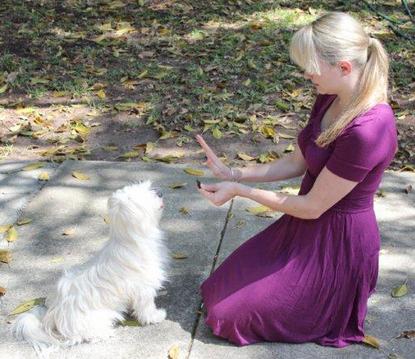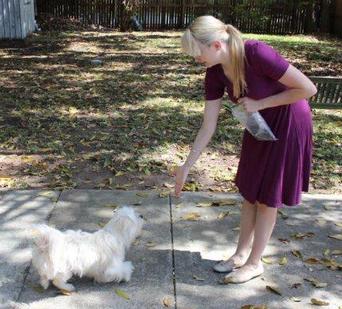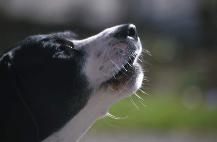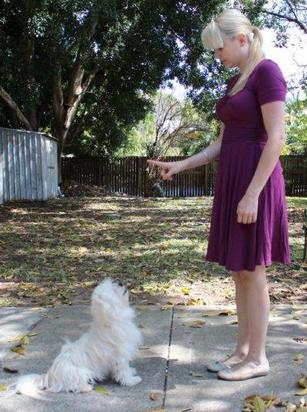Leave it Alone, Pooch! (continued)
Firstly you need to know how to talk dog. If you haven’t read that already you should refer to the sister facts sheet, Talk Like a Dog for more details before going further.
The “LEAVE” Command
The following examples will clarify the use of the “LEAVE” command for several different applications.
STEP ONE:- Learn how to talk in “Doglish”
In in the video below (chapter one ), Dr Cam explains the difference between English and “Doglish”. If you want to know how to talk like a dog, watch this video!
STEP TWO: Pulsed, Reward-Based Training and the Circle of Commands
In chapter two Dr Cam explains the benefits of using reward based training to help your dog become a better and happier pet.
Start with something easy – teach your dog the three-step’Circle of Rewards’ represented by the human words of :-
‘SEEK (the food treat that’s throw away along the floor) –> COME to me and –> SIT your hairy little butt on the ground for 5 full seconds – and then I will reward you.’
Here’s a video of that three-step Circle of Rewards
STEP THREE: IQ Testing and the LEAVE Routine
In chapter three of Dr Cam explains how important it is to understand your dog’s learning abilities and shows you how to test it.
The next step is to condition the dog to recognize the addition of the word “LEAVE” to the above.
This is done by training your dog to “LEAVE” a food reward alone for five seconds when your dog has done the SIT.
Twice daily, for five days involve your dog in the following training session. Place it in a SIT position. Place a food reward in front of it. Using your commanding voice (the second voice discussed above) command it to “LEAVE” the food reward alone. Use a hand signal to make the command clear.
STEP FOUR:- Using the Circle of Commands and the LEAVE Routine together
In chapter four, Dr Cam explains to Yvette how to create the Circle of Rewards from a few simple behaviours.
STEP FIVE: The Chaos to Calm model
In chapter five Dr Cam explains how to calm your dog during chaotic times in a few simple steps, using the Circle of Rewards
Dr Cam also discusses the above routine in this podcast
Wait for five seconds to test the dog’s response. If your dog leaves the food reward alone for this period, command it to eat the food using a specific command such as “OK” and then immediately praise it, enthusiastically, as it gobbles the food. Give lots of pats, hugs and kisses!
What if the dog doesn’t leave the food reward alone for the five-second test period? You could punish it using the BAD DOG voice but that is not the way a SNAPO does things! Instead, just pinch the food reward before your dog can get it. Then go through the command again. You will be surprised at how quickly your dog will learn this. When I demonstrate this for my clients for the first time, clever dogs will learn this “LEAVE” command after I ‘pinch’ the food twice. The worst I have seen required me to pinch the food eighteen times before it finally got the message.
Repeat the “LEAVE” command fifteen times in each training session. As you are using a training session twice daily for seven days, you will be using thirty repetitions of a joyful routine. That make 210 repetitions in a week!! This is called cognitive therapy.
At the end of the week, your dog will really understand that whenever he or she hears the word “LEAVE” a food reward or hug, kisses or pats are to follow.
As your dog learns, start to lessen the number of food rewards you give and replace them with pats and hugs.
STEP SIX: The “Good Dog Routine”

Let’s assume your dog is aggressive towards other dogs. You have already trained your dog to respond to the “LEAVE” command and he or she really likes the food, hugs and pats and is sensitised to word “LEAVE”. Have your dog on a lead in the local park. Station it ten meters or so from a normal walking path that dogs and owners are likely to travel. Watch your dog as you notice another dog and owner approach.
Immediately you see that your dog has noticed the other, give the word “LEAVE” in the command voice discussed above. Wait for the therapeutic five seconds. If your dog ignores the other and focuses on you, it has done a wonderful thing, Turn and walk away as you give the dog a food reward. At the same time, praise it with pats and hugs and that GOOD DOG voice.
What a winner! This is a positive reinforcement routine.
If your dog does not respond in that five seconds and is still focused on the approaching pooch then go immediately to Step three.
STEP SEVEN: The ‘Bad Dog – Good Dog Routine
The ‘Bad Dog – Good Dog Routine’ is used when your dog has done something wrong. It has erred in this example because it has not responded to your command. Who’s in control now?
In that five-second window, as soon as you see that your dog is not responding, issue a louder “LEAVE” – but don’t go overboard with that.
- It works really well if you shake a liver treat packet when you do that – it builds up arm muscles of therapy!
- If often works really well if you move quickly towards your dog as you shake the liver treat packet.
Wait for the therapeutic five seconds and if your dog is now behaving, turn and walk off saying COME.
After a few steps, command SIT and praise your dog after 5 secons of the laser lock sit and give it the food reward.
You won this time, and the louder voice was only used to distract the dog so that you could get to the reward.
What if the dog still does not respond to the ‘Bad Dog – Good Dog Routine’? The dog is about to win unless you pull something out of the bag. This is where the Salvage Position comes in.

STEP EIGHT: The ‘Salvage Position’
We need to rescue what is turning into an uncontrolled situation. Don’t issue any further “LEAVE” commands as you will then be training your dog to ignore you. As soon as you notice your dog is not in control during this second five-second pause, turn and walk off briskly with the dog at a fast walking or jogging pace. This will quickly bring your pesky pooch under control. When you can see that it is responding to you and not the other dog, issue some firm obedience commands and as you can see it is starting to respond, quickly soften your sternness and get back to the standard commanding voice and the ‘Good Dog Routine’ praise.
The Salvage Position is important. If all else fails, it insures that the dog is not able to reinforce its own aggression towards the other dog and that, at least in some form, you win the confrontation.
Some additional techniques
In the early stages of training, you will be using more of the ‘Bad Dog – Good Dog Routine’ than the ‘Good Dog Routine’. In fact, being practical, your pooch may react too quickly to the other approaching dog and you will find that you do not have the time to use the ‘Good Dog Routine’.
In such a case, you may need to leap immediately to the ‘Bad Dog – Good Dog Routine’. In other cases, the only solution may be the Salvage Position. At least this is better than allowing your dog to get away with the unwanted behaviour.
As you get used to the process and are able to concentrate more on what the dog is doing rather than on your own response to the dog, the process will get easier.
For ballistic backyard barkers

For dogs that bark excessively in your back yard, the same “LEAVE” routine can be used with only minor modification. Have a ‘strap lead’ trailing from your dog’s collar. This is made from a flat nylon lead about sixty centimeters long that is readily available from supermarkets. Cut the loop from the end and sear the end in a flame to stop if from fraying. Removing the loop prevents the strap lead from getting caught as it trails from your dog’s collar. Only place this lead on your dog when you are with it – not when it is unattended.
Wander casually around your yard when the dog is loose. As soon as your dog starts to bark, issue the “LEAVE” command using the ‘Good Dog Routine’. Proceed as needed using the ‘Bad Dog – Good Dog Routine’ if you have to but as you issue the second (punishing) “LEAVE” command, start walking to your dog in case you need to use the Salvage position. If the Salvage Position is needed, grab the strap lead, turn and walk off briskly. From there proceed as listed above.
For dogs that are over-attentive to visitors
The “LEAVE” routine works well here. Follow the generalities of the process listed, but have a lead permanently secured to the skirting board in your lounge room. Have a mat near the tether as a focus for your dog. If your dog is not responding, the salvage position is to place the dog, gently, on the tether until it calms down. When it is quiet, it can be removed from the lead and brought back into the fray. The
“LEAVE” command can be used to control attention seeking again and the tether is used each time the dog does not respond.
However, if the dog is really being difficult, ‘time it out’ in the bathroom or laundry. It will soon learn.
For dogs that chase other animals
Another ‘pre-training’ step is useful here. After training your dog to “LEAVE” a food reward alone, train it to “LEAVE” a toy when it is thrown. Put the dog is a SIT/STAY position, grasp its collar, command “LEAVE” and then throw the ball. Let the ball bounce and when it stops, command your dog to FETCH the ball.
When your dog learns this, change the routine by throwing a ball and commanding “LEAVE” when the dog is in full flight. The object is to get your dog to stop, wait for the next command, and then to resume fetching the ball.
This will make the “LEAVE” command much more predictable when your dog is intent on chasing a real animal – but be careful – another animal’s life can be in danger here.
The “LEAVE” command is certainly powerful and very effective. Remember that the goal is to get your dog to recognize that if it does “LEAVE” things alone, a reward will follow. The pre-training is essential and should be continually reinforced in your normal day to day activities with your prize pooch. Lastly, don’t forget that proper use of your voice is essential too.
More information
Step 1 Some Basic Obedience Commands
Step 2 Getting Good Behaviour from Dogs
Step 3 Talk Like a Dog!
Step 4 Leave it alone Pooch

